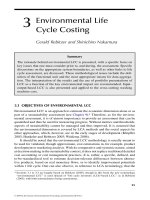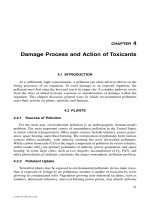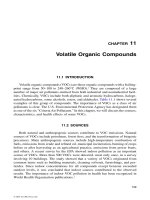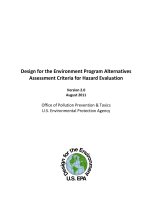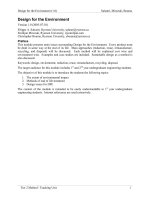Product Design for the Environment: A Life Cycle Approach - Chapter 11 potx
Bạn đang xem bản rút gọn của tài liệu. Xem và tải ngay bản đầy đủ của tài liệu tại đây (689.86 KB, 29 trang )
Part III
Methods, Tools, and
Case Studies
2722_C011_r02.indd 2952722_C011_r02.indd 295 11/30/2005 1:50:34 PM11/30/2005 1:50:34 PM
© 2006 by Taylor & Francis Group, LLC
297
Chapter 11
Product Constructional System Defi nition
Based on Optimal Life Cycle Strategies
The design of products with good environmental performance over their
entire life cycle requires the development of methods and models that provide
as complete a vision of the problem as possible, and allow the optimization
of product architecture and components while respecting the constraints
imposed by their main functional performances.
This chapter presents a method for Life Cycle Design, focusing on the analy-
sis of strategies extending the useful life (maintenance, repair, upgrading, and
adaptation of the product) and strategies of recovery at the end-of-life (direct
reuse of components and recycling of materials). This analysis and design
method is able to evaluate the most suitable strategies for each component and
subassembly comprising the product, and to defi ne the best redesign choices
in terms of certain characteristics of product architecture and components. It is
based on a process of analysis and decomposition of the conventional construc-
tional system and its reinterpretation in terms of the life cycle strategies, by
means of the modularity concept and the Design for Disassembly approach. To
clarify this method, the development of a redesign proposal for a widely used
household appliance, the refrigerator, is described.
The fundamental issues in this chapter were previously introduced in
11.1 Aims and Approach
This chapter presents a method, complete with fundamental mathematical
modeling, to aid the study of product constructional systems and investigate
their environmental effi ciency. The latter can be determined in various ways.
The approach proposed here seeks to optimize the life cycle strategies that
appear to be more effective for an environmentally effi cient life cycle
(Section 9.1, Chapter 9):
• Those strategies aimed at maintaining performance and functionality
of product during the phase of use (maintenance, repair, upgrading,
2722_C011_r02.indd 2972722_C011_r02.indd 297 11/30/2005 1:50:35 PM11/30/2005 1:50:35 PM
© 2006 by Taylor & Francis Group, LLC
Chapter 9.
298 Product Design for the Environment
and adaptation of the product), in that they can favor the extension
of the product’s useful life
• Those strategies oriented toward the planning of recovery processes
at the end of the product’s useful life (direct reuse of components
and recycling materials in the primary production cycle or in exter-
nal cycles), in that they are directed at reducing the environmental
impact of disposal and at the recovery of resources
These types of interventions can be translated into clear environmental
benefi ts: reduction of the volumes of the virgin materials required; exten-
sion of the product’s working life; closing the cycles of the resource fl ows in
play by recovery operations. The proposed tool is conceived to support two
action typologies:
• Analysis of conventional constructional systems for a correct defi -
nition of the life cycle strategies most appropriate to preexisting
products
• Redesign of architectures and components for the improvement of
environmental performance and for the development of new, envi-
ronmentally acceptable products
To translate the strategies of extension of useful life and recovery into requi-
sites of product architecture and components, we propose the modularity
(Chapter 9, Section 9.3.3), which focus on harmonizing product layout, geom-
etries, and joining systems in terms of the separability of the parts.
11.2 Method and Tools for Analysis and Design
An analysis and design intervention characterized by the premises outlined
above is complex and requires a methodology that provides a procedure and
supporting tools for the defi nition and correct interpretation of environmen-
tal requirements. Such a methodology must also identify the most effective
elements of successful product redesign.
The method developed here is divided into certain successive moments,
tion of the conventional constructional system, which identifi es the deter-
mining characteristics of the product architecture, the unavoidable design
constraints, and the primary functional components. Then follows an evalu-
ation of the most appropriate strategies of extension of useful life and of
product architecture (reinterpreted using the evaluation tool) is mapped to
2722_C011_r02.indd 2982722_C011_r02.indd 298 11/30/2005 1:50:35 PM11/30/2005 1:50:35 PM
© 2006 by Taylor & Francis Group, LLC
concept (Chapter 9, Section 9.4) and the Design for Disassembly approach
summarized in Figure 11.1. The fi rst phase is the analysis and decomposi-
recovery, according to the system characteristics. Finally, the conventional
Product Constructional System Defi nition 299
evidence the distribution of the most appropriate strategic options in rela-
tion to the characteristic properties of the product’s various parts. This offers
views of the system that can suggest the most effective design interventions
and recommend the structure of the architecture and modularization of the
system that best respect these options.
At the component and junction design level, this last phase requires the
ing the separability of the new constructional system (allowing the disassembly
of the main components) and making it possible to apply the optimal strategies.
A product that provides for relatively easy separation of its parts or compo-
nents can facilitate product maintenance, repair, and updating, and the separa-
tion of components and materials for recovery at the end of its useful life.
This type of investigation can have dual goals: the defi nition of the most
suitable strategies to apply to predefi ned, conventional constructional systems,
and development of new architectures aligned with the most effective strate-
gies for extending useful life and recovery of resources.
11.2.1 Product Constructional System and Design Choices
In general, “product architecture” refers to the arrangement and relation-
ships of the physical blocks comprising the functional elements of a product
FIGURE 11.1 Summary of analysis and design method.
2722_C011_r02.indd 2992722_C011_r02.indd 299 11/30/2005 1:50:35 PM11/30/2005 1:50:35 PM
© 2006 by Taylor & Francis Group, LLC
Design for Disassembly approach (Chapter 9, Section 9.3.3), directed at ensur-
(Ulrich and Eppinger, 2000). “Functional elements” are those units that
300 Product Design for the Environment
perform single operations and transformations that contribute to the overall
product function. Defi ning product architecture thus consists of defi ning its
approximate geometric confi guration (layout) and identifying the interac-
tions between its main units or modules. A successive level of analysis refers
to the defi nition of component characteristics (dimensions, shape, material)
and of junction systems.
Product constructional system is defi ned in two successive levels of design
choices:
• Modularity and layout (embodiment design)
• Properties of components (detail design)
These choices, in turn, determine two corresponding typologies of component
characteristics: separability and accessibility, and performance (durability, reli-
ability and other physical characteristics).
11.2.2 Analysis and Decomposition of Product Architecture
Among the different approaches to architecture decomposition, decomposi-
tion by modularity is considered more appropriate in this context because it
analyzes the independence of functional and physical components. Unlike
structural decomposition, which is restricted to a hierarchical model of the
system, decomposition by modularity exploits the lack of dependency between
physical components of the design (Kusiak and Larson, 1995). This choice is
motivated by the strategic value that architecture modularity has in relation to
In the method proposed here, the analysis and decomposition of product
architecture consists of three phases:
• Defi nition of the main functional units
• Analysis of the interaction between units (and defi nition of the
consequent layout constraints)
• Analysis of the characteristic performances required of each unit
The functional units are those that collectively produce the overall functioning
of the system, divided into physical blocks that perform the single operations.
Therefore, the defi nition of functional units requires an initial, function-based
decomposition (Kirschman and Fadel, 1998). First, the overall function is deter-
mined for the system. Then, depending on its complexity, it is broken down
into subfunctions which, if necessary, may be decomposed again to produce
a functional graph that approximates the subsystem boundaries and trans-
lates the functional units into physical blocks.
2722_C011_r02.indd 3002722_C011_r02.indd 300 11/30/2005 1:50:35 PM11/30/2005 1:50:35 PM
© 2006 by Taylor & Francis Group, LLC
the design of product life cycle, fi rst described in Chapter 9, Section 9.4.
Product Constructional System Defi nition 301
The results of the analysis of the interactions between the units may be
expressed by a symmetrical interaction matrix:
IU iu
ij
nxn
ϭ
⎢
⎣
⎥
⎦
(11.1)
where iu
ij
represents the interaction (value of 1 or 0) between the i-th and j-th
units (Kusiak, 1999).
Analyzing the characteristic performance of the functional units consists of
defi ning the performance constraints that, for each unit, can be expressed by
one or more functions of the type:
Pf Pf Gf, Gv, Sh, MtPpϭ
(
)
(11.2)
where Pf represents the characteristic performance, Gf and Gv are the fi xed
and variable geometric parameters, respectively, Sh represents the form char-
acteristics, and MtPp represents the properties of the material (Giudice et al.,
2005).
11.2.3 Investigation Typologies
As mentioned above, the method proposed here supports two different
investigation typologies:
• Analysis of conventional constructional systems for a correct defi ni-
tion of the most suitable interventions for preexisting products and
an evaluation of environmental criticality
• Product redesign for the improvement of environmental perfor-
mance in the life cycle
11.2.3.1 Analysis of Criticality and Potentiality of the
Conventional System
At this level of intervention, the proposed method is directed at the best
mapping of strategies for extending useful life and recovery at end-of-life,
according to the properties of the preexisting construction units. This mapping
is achieved using the matrix of strategy evaluation described below. The matrix
translates certain determinant factors for the single strategies into component
suitability to the strategy. The determinant factors, as shown below, are classi-
fi ed as dependent on, or independent from, the design choices.
In the case where a preexisting structure is analyzed, the design choices
have already been made and therefore the entire set of these factors must be
2722_C011_r02.indd 3012722_C011_r02.indd 301 11/30/2005 1:50:35 PM11/30/2005 1:50:35 PM
© 2006 by Taylor & Francis Group, LLC
302 Product Design for the Environment
evaluated to defi ne the optimal strategies. From the analysis of the conven-
tional constructional system it is possible to:
• Defi ne the main components and their constituent materials
• Identify the functional units
• Evaluate the modularization of the architecture by analyzing the
correspondence between functional units and components
• Analyze the interactions between the components (which must
respect the necessary interactions between functional units)
This provides a matrix of component interaction:
IC ic
ij
mxm
ϭ
⎢
⎣
⎥
⎦
(11.3)
Using the matrix of strategy evaluation, it is possible to quantify the relevance
of each main component of the product in relation to each strategy of useful
life extension and end-of-life recovery. Then, to ensure that the most suitable
strategies are actually feasible, the architecture must allow the necessary sepa-
rability of the components. To evaluate separability, which represents the
main criticality of the architecture, the matrix defi ned by Equation (11.3) must
be transformed into a matrix of the irreversible junctions (each interaction is
translated into junction)
IC* ic*
ij
mxm
ϭ
⎢
⎣
⎥
⎦
(11.4)
where ic*
ij
is 1 if the junction between the i-th and j-th components is irrevers-
ible, and 0 if it is reversible or nonexistent, or if i ϭ j. The separability of the
components can then be expressed by the following vector:
SC sc sc sc where sc
1im i
ϭ
(
)
=−
=
∏
(*)1
1
ic
ij
j
m
(11.5)
The i-th component is separable if sc
i
ϭ 1, otherwise it is inseparable (sc
i
ϭ 0 ).”
11.2.3.2 Redesign of Product
From the viewpoint of Life Cycle Design, the modularization of the
constructional system must achieve two main objectives regarding life cycle
2722_C011_r02.indd 3022722_C011_r02.indd 302 11/30/2005 1:50:36 PM11/30/2005 1:50:36 PM
© 2006 by Taylor & Francis Group, LLC
Product Constructional System Defi nition 303
requirements: the independence of components belonging to different
modules, and the affi nity of components of the same module (Gershenson
et al., 1999). This assumption is the foundation of redesign intervention.
The fi rst phase of system redesign is the analysis of opportunities for archi-
tecture redesign based on the functionality and performance constraints
imposed on the main units, introduced in Section 11.2.2 and expressed by the
interaction matrix (11.1) and by a function set of type (11.2). In architecture
redesign, the tool used for the evaluation of optimal strategies ignores the
determinant factors directly dependent on design choices (which must subse-
quently be optimized), and takes into account only those dependent on
factors external to the design choices (required characteristics and function-
ality, conditions of use).
The results of this fi rst analysis, dependent on solely external factors, indi-
cate which design choices would respect the predisposition of each compo-
nent to useful life extension and end-of-life strategies. With these results it is
also possible to identify any affi nities that may exist between components.
Components similar in terms of suitability for both the strategies and the
required functional performance can be appropriately grouped and modu-
larized, in order to facilitate, for each module identifi ed, the most appropriate
servicing or recovery operations (Marks et al., 1993). These indications are
then implemented in the fi rst level of design choices (layout, modularity)
that falls within the domain of the embodiment phase of the design process
modify the interaction matrices of the functional units (11.1) and of the
components (11.3).
The next level of design choices (that of components—typology of materi-
als, durability, reliability) that falls within the domain of the detail design is
approached in terms of:
• Required performance characteristics, expressed by (11.2)
• Indications obtained from the preliminary evaluation of the optimal
strategies
The optimal choice is identifi ed by varying the design parameters and evalu-
ating the subsequent effects on the strategy distribution.
To complete redesign, the degree of appropriate separability can be identi-
fi ed for each module, in order to ensure a reduced impact (generally economic)
of the disassembly phase. Therefore, the system of junctions must be defi ned
so that it ensures:
• Functional interaction between components
• Separability, enabling the strategies identifi ed as optimal for each
component
2722_C011_r02.indd 3032722_C011_r02.indd 303 11/30/2005 1:50:36 PM11/30/2005 1:50:36 PM
© 2006 by Taylor & Francis Group, LLC
(Chapter 7). Having redefi ned the main components, it is necessary to
304 Product Design for the Environment
Also in this case, separability also depends on the system of junctions through
a matrix of type (11.4) and can be expressed using a vector as in (11.5). The
required separability becomes the objective of the Design for Disassembly
intervention, which guides the fi nal phase of redesign at the component and
11.2.4 Verifi cation Tools
The results of redesigning must be analyzed to evaluate their effectiveness in
extending the product’s useful life, these results can be evaluated using the
tools for the analysis of product serviceability, which quantify its level of
maintainability and reparability as a function of constructional system effi -
ronmental impact, it is possible to apply the tools of Life Cycle Assessment
(LCA), which allow the evaluation of the environmental impact of the opti-
By evaluating the redesigned product in this way and comparing the
results with those obtained on the conventional system, it is possible to
determine the effectiveness and the success of the redesign, and its resulting
benefi ts.
11.3 Optimal Life Cycle Strategy Evaluation Tool
The evaluation tool that enables useful life extension and recovery strategies
to be related to the product parts and subsystems consists of a set of matrices
that quantify the relevance of each main component in terms of each practi-
cable strategy. This quantifi cation is obtained by evaluating the potentiality
of the components in relation to the determinant factors for each strategy
(Chapter 9, Sections 9.2.3 and 9.3.5).
11.3.1 Determinant Factors for Strategies
The determinant factors are properties of components that render them
appropriate for the application of one or more of the life cycle strategies
under examination. For example, a component that requires frequent clean-
ing and is particularly susceptible to deterioration is a good candidate for
regular maintenance; thus, the need for cleaning and the susceptibility to
2722_C011_r02.indd 3042722_C011_r02.indd 304 11/30/2005 1:50:36 PM11/30/2005 1:50:36 PM
© 2006 by Taylor & Francis Group, LLC
terms of reaching the desired goals (Section 3.2.3, Chapter 3). With respect to
mized product’s life cycle (Chapter 4).
junction system levels (refer to Chapter 9, Part Design and Joint Design,
Section 9.3.3.1 and Table 9.2).
ciency (Chapter 9, Section 9.2.2,). To evaluate performance in terms of envi-
Product Constructional System Defi nition 305
physical deterioration can be considered determinant factors for the mainte-
nance strategy.
Determinant factors, as noted above, are distinguished by their depen-
dence on, or independence from, the design choices. The former (durability,
reliability, resistance) are directly dependent on choices made at the compo-
nent level (materials, geometry). They are generally quantifi able by evaluat-
ing physical–mechanical properties and by applying tools and techniques
latter type depend on factors external to design choices (required character-
istics and functionality, conditions of use). Generally, their quantifi cation
can only be based on qualitative evaluations.
The determinant factors that will be considered here are summarized in
depending on design choices are displayed in italics.
11.3.2 Implementation of Matrices for Analysis of Strategies
create a strategy analysis matrix, the main components must fi rst be entered
according to the indications obtained from the preliminary analysis and
decomposition of product architecture.
Each component has a line of evaluation terms, one term for each determi-
nant factor for the strategy for which the potential of the components is to be
evaluated. In this way a matrix can be developed for each strategy, completed
TABLE 11.1 Extension of useful life strategies and determinant factors
MAINTENANCE CLEANING NEED
PHYSICAL DETERIORATION
DURATION
REPAIR
DAMAGE RISK
RELIABILITY
DURATION
UPGRADING or ADAPTATION
OBSOLESCENCE
USE MODE CHANGES
USE ENVIRONMENT CHANGES
The determinant factors that depend on design choices are italicized.
2722_C011_r02.indd 3052722_C011_r02.indd 305 11/30/2005 1:50:36 PM11/30/2005 1:50:36 PM
© 2006 by Taylor & Francis Group, LLC
for the analysis of component duration and life prediction (Chapter 10). The
Tables 11.1 and 11.2 in relation to each strategy under examination. Those
Figure 11.2 shows the basic set of matrices for evaluation of strategies. To
306 Product Design for the Environment
by a fi nal column consisting of global evaluation terms representing the
overall evaluation of each component. These fi nal terms are the sum of the
terms in the corresponding matrix line, appropriately weighted according to
the importance of each determinant factor.
For example, to evaluate a component’s potential in relation to maintenance
strategies, the corresponding matrix will consist of three columns, one for each
terms quantifying each component’s need of cleaning operations. The second
column will consist of terms quantifying each component’s susceptibility to
FIGURE 11.2 Scheme of strategy evaluation matrices.
TABLE 11.2 End-of-life strategies and determinant factors
REUSE OF PARTS
PHYSICAL DETERIORATION
TECHNOLOGICAL OBSOLESCENCE
DURATION
RECYCLING OF MATERIALS
PHYSICAL DETERIORATION
TECHNOLOGICAL OBSOLESCENCE
DURATION
RECYCLABILITY
The determinant factors that depend on design choices are italicized.
2722_C011_r02.indd 3062722_C011_r02.indd 306 11/30/2005 1:50:36 PM11/30/2005 1:50:36 PM
© 2006 by Taylor & Francis Group, LLC
determinant factor for maintenance (Table 11.1). The fi rst column will consist of
Product Constructional System Defi nition 307
deterioration. The third column will consists of terms quantifying each
component’s lifespan. Further (conclusive) column will report the overall
evaluations.
In a fi rst analysis, the terms of intermediate and overall evaluation could
be based on a qualitative evaluation of the determinant factors for each strat-
egy. A quantitative evaluation approach may be formulated (Giudice et al.,
2002), based on the mathematical model summarized as follows.
Have C
i
indicate the i-th of the m components comprising the product,
and have DF
j
X
indicate the j-th of the n
X
determinant factors for the practi-
cable strategy X. The matrix M
X
for the evaluation of strategy X can be
expressed as:
M = m
x
ij
x
i = 1,2, . . . ,m
j = 1,2, . . . ,n
x
⎡
⎣
⎤
⎦
(11.6)
where the term m
ij
X
quantifi es the j-th determinant factor for the strategy X,
relative to the i-th component.
Then have w
j
X
indicate the weight of the j-th determinant factor for strategy X.
The aptness A
i
X
of the i-th component C
i
to strategy X represents the Index of
Strategy X for the i-th component:
A w m
i
x
j
x
j=1
n
ij
x
x
ϭ
∑
⋅
(11.7)
A correct use of the proposed model requires not only an appropriate quan-
tifi cation of the strategy determinant factors, but also their normalization to
render them homogeneous in relation to the application of (11.7), and an
evaluation of the weighting of each factor in relation to the strategy.
11.4 Case Study: System Analysis and Redesign of a
Household Refrigerator
Large, domestic electrical appliances (refrigerators, washing machines, dish-
washers) generally have an average life estimated at about 10 years. This
period represents the potential life of the product since it corresponds to a
prevision of usefulness (i.e., to the time it is anticipated the appliance can
This potential life can be signifi cantly reduced by the design cycle (i.e., the
interval of time between successive generations of the product), whereby the
production of a model is discontinued four to fi ve years after its fi rst appear-
ance on the market. This characteristic of brief effective useful life, together
2722_C011_r02.indd 3072722_C011_r02.indd 307 11/30/2005 1:50:37 PM11/30/2005 1:50:37 PM
© 2006 by Taylor & Francis Group, LLC
maintain its primary functions—physical life, see Section 9.1 of Chapter 9).
308 Product Design for the Environment
with their widespread use in all domestic environments, makes electrical
appliances particularly sensitive to problems of retirement and recovery.
In the case of the refrigerator, this problem is amplifi ed by the large variety of
product typologies produced to meet varying consumer demands, which can
make it vulnerable to a further reduction in its useful life. This is compounded
by a problem of recovery resulting from the conventional product construc-
tional system that, at present, combines a wide variety of different and incom-
patible materials inseparably (EC-VHK, 1999). The walls of refrigerators, in
particular, are composed of metals, plastics, and PUR foam glued together;
because they cannot be disassembled or dismantled, they are usually cut up,
shredded, or ground up (Lambert and Stoop, 2001).
These problems have led to legislative pressures and incentives intended to
limit the environmental impact of this specifi c manufacturing sector, operat-
ing on many phases of the life cycle. In the European Union, for example, use
of refrigerating fl uids and foaming agents responsible for increased deteriora-
tion of the ozone layer and global warming (chlorofl uorocarbons—CFCs) has
been discouraged or suppressed. The introduction of energy labels showing
products’ energy consumption has been complemented by certifi cation of
products’ overall eco-compatibility, within the EC’s eco-label award scheme
eco-label to refrigerators was issued in 1996; in its 1999 revision (2000/40/
EC), the previous criteria were integrated with explicit requirements regard-
ing the extension of useful life (lifetime extension) and the facilitation of prod-
uct disassembly for recovery and recycling at end-of-life. That revised directive
required that joints must be easy to fi nd and be accessible, electronic assem-
blies and the whole product must be easy to dismantle, and incompatible and
hazardous materials must be separable. These key criteria were confi rmed in
the last revision (2004/669/EC).
11.4.1 Preliminary Analysis of System
Following this methodology, the fi rst phase consists of a preliminary analysis
and decomposition of the constructional system to defi ne the main functional
units, the interactions between units (and consequent layout constraints), and
the characteristic performances required of each unit. In the case of the refrig-
and associated with their main performance characteristics. The matrix of the
11.4.2 Analysis of Criticality and Potentiality of the
Conventional Architecture
From the analysis of the conventional system it is possible to defi ne the main
components and their materials and to identify the functional units, as shown
2722_C011_r02.indd 3082722_C011_r02.indd 308 11/30/2005 1:50:37 PM11/30/2005 1:50:37 PM
© 2006 by Taylor & Francis Group, LLC
(Chapter 1, Section 1.6.1). The fi rst EC directive on criteria for awarding the
erator, the six main functional units summarized in Table 11.3 were identifi ed
interactions between the main units (11.1) is reported in Table 11.4.
Product Constructional System Defi nition 309
ing action generated by the cooling plant 5 to the internal cell 4) coincides
with part of the plant itself (evaporation plate); thus, units U
5
and U
6
are
grouped together in a single component C
5
(cooling plant).
From the conventional architecture analysis it is also possible to determine
the main criticality—the impossibility of separating the parts at the end of the
working life because of the foam insulation element that joins all the cabinet
components and part of the cooling system. This criticality is expressed by the
reported in the upper part and the consequent vector of component separabil-
ity (11.5) is given on the lower line.
This analysis was directed at producing the most correct mapping of the
strategies of extension of useful life and recovery at end-of-life, in relation to
the properties of the components. This mapping was achieved using the
strategy evaluation matrix described above (Section 11.3). Use of the matrix
quantifi es the relevance of each essential component of the product in rela-
tion to each feasible strategy.
ing to the reuse strategy. Using the matrix in an analogous manner, it is
TABLE 11.3 Functional units and main performances requested
FUNCTIONAL UNITS MAIN PERFORMANCES REQUESTED
U
1
External casing Shock resistance, structural sturdiness, thermal insulation
U
2
Rear panel Thermal insulation
U
3
Thermal insulator High thermal insulation, structural sturdiness
U
4
Internal lining Hygienic and washable, structural sturdiness, thermal
insulation
U
5
Plant Thermodynamic performance
U
6
Plant–cell interface Thermal insulation
TABLE 11.4 Functional interaction between main units
U
1
U
2
U
3
U
4
U
5
U
6
U
1
011010
U
2
101000
U
3
110100
U
4
001001
U
5
100001
U
6
0 0 0 1 1 0
2722_C011_r02.indd 3092722_C011_r02.indd 309 11/30/2005 1:50:37 PM11/30/2005 1:50:37 PM
© 2006 by Taylor & Francis Group, LLC
matrix reported in Table 11.5, where the irreversible junctions (11.4) are
in Figure 11.3. It can be seen that in this case, unit 6 (which transfers the cool-
As an example, Figure 11.4 shows the application of the matrix correspond-
possible to map the various strategies under examination, indicated by a
specifi c color for each strategy, where the color intensity represents the suit-
mapping relative to reuse, highlighting the components with the greatest rele-
vance in relation to this end-of-life strategy.
strategy under examination (maintenance, repair, reuse, and recycling). Of
are taken as preestablished parameters, are highlighted. Once quantifi ed, the
parameters are broken down into value ranges of four different levels (0, zero;
1, low; 2, medium; 3, high). The fi gures also show the corresponding strategy
indices calculated according to the weighting method introduced above
(Section 11.3.2).
If cleaning operations are excluded, the component requiring the most
servicing (maintenance and repair) is the cooling plant. This component is
not completely separable from the rest of the structure, as is confi rmed by the
polyurethane foam). Therefore, only some parts of the cooling plant have a
good level of serviceability.
Strategies for end-of-life involve the polyurethane insulation (for reuse)
and the metal and polymer casings. However, once again the zero separabil-
ity of these components does not permit optimal strategies to be applied.
310 Product Design for the Environment
FIGURE 11.3 Analysis and decomposition of a conventional system.
2722_C011_r02.indd 3102722_C011_r02.indd 310 11/30/2005 1:50:37 PM11/30/2005 1:50:37 PM
© 2006 by Taylor & Francis Group, LLC
information reported in Table 11.5 (the evaporators are embedded in the
ability of the components in relation to the strategy. Figure 11.4 shows the
the determinant factors for each strategy, those dependent on design choices
(material typology, reliability, and durability), which in this type of analysis
F igures 11.5 and 11.6 show the strategy evaluation matrices regarding each
Product Constructional System Defi nition 311
In conclusion, the desired environmental potentials cannot be realized in
this case, highlighting the criticality of the conventionally manufactured
results of the LCA, performed with SimaPro 4.0
®
software (Pré Consultants
BV, Amersfoort, The Netherlands), using the Eco-indicator 95 impact assess-
making up the entire life cycle were incorporated in the analysis. As a result,
the environmental impacts of the manufacturing, use (hypothesizing a life of
eight years), and disposal phases are quantifi ed (the Eco-indicator method
TABLE 11.5 Irreversible junctions and separability of components
U
1
C
1
U
2
C
2
U
3
C
3
U
4
C
4
U
5+6
C
5
U
1
00100
U
2
00100
U
3
11011
U
4
00100
U
5+6
00100
00000
FIGURE 11.4 Application of a strategy evaluation matrix and mapping
of the system: Reuse.
2722_C011_r02.indd 3112722_C011_r02.indd 311 11/30/2005 1:50:37 PM11/30/2005 1:50:37 PM
© 2006 by Taylor & Francis Group, LLC
product due to the poor separability of its components. Figure 11.7 shows the
ment method (Chapter 4, Section 4.2 and Table 4.3). The main processes
312 Product Design for the Environment
expresses the impacts in Point–Pt). The fi rst two phases lead to the greatest
impact; the disposal phase consists exclusively of dumping.
11.4.3 Redesign of the Constructional System
Careful analysis of the strategies mapped in this way can suggest ways to
reinterpret the product architecture, which then becomes the starting point
for redesigning the constructional system. From the analysis of potentiality
and criticality it is possible to identify the problems and limitations
presented by the conventional system, which in the case under examina-
tion are principally:
• Dispersion of the thermodynamic plant in the entire system
• Heterogeneity of the materials used (metals and polymers)
• Impossibility of separating the parts at end of use due to the foam
insulating element that binds together all the components of the
refrigerator cabinet
Having defi ned the main problems resulting from the conventional system
analysis, it is possible to identify the priority objectives of redesign:
• Separation of the refrigeration system from the structure—The ther-
modynamic system must be separated from the rest of the refrigerator
FIGURE 11.5 Conventional system: Matrices for life cycle strategy evaluation and strategy indi-
ces (Maintenance and Repair).
2722_C011_r02.indd 3122722_C011_r02.indd 312 11/30/2005 1:50:38 PM11/30/2005 1:50:38 PM
© 2006 by Taylor & Francis Group, LLC
Product Constructional System Defi nition 313
and enclosed in a cooling module easily accessible for servicing opera-
tions and separable for substitution and reuse.
• Separability of the cabinet—The main components of the refrigerator
cabinet (external covering, insulation, internal lining) must be designed
in a way that allows simple, stable, and reversible disassembly to facil-
itate disassembly at end of use, while meeting structural and thermal
requirements.
FIGURE 11.6 Conventional system: Matrices for life cycle strategy evaluation and strategy indi-
ces (Reuse and Recycling).
FIGURE 11.7 LCA for the conventional system.
2722_C011_r02.indd 3132722_C011_r02.indd 313 11/30/2005 1:50:38 PM11/30/2005 1:50:38 PM
© 2006 by Taylor & Francis Group, LLC
314 Product Design for the Environment
• Choice of materials—The materials must be chosen in a way that
provides optimal stratifi cation from the point of view of the specifi c
properties and functions required of each component.
The fi rst phase of redesign involves the use of tools to evaluate the optimal
strategies, ignoring determinant factors directly dependent on design choices
(which must be optimized subsequently) and considering only those depen-
dent on factors external to design choices. The results of this fi rst phase are
(Figure 11.8), if cleaning operations and damage on external casing due to
accidents (unit 1) are excluded, the need for maintenance and repair is concen-
trated in the cooling plant (unit 5). This suggests making design choices that
respect this predisposition so that servicing is concentrated on the single most
sensitive unit, making all its components separable from the product and
easily accessible.
The other two matrices (Figure 11.9) identify the units offering the best
opportunities for reuse (units 2, 3, 6) and those most suitable for recycling
(units 1, 4). Unit 5 offers broadly equivalent opportunities (the complexity of
the cooling system requires, however, a deeper level of analysis). In this case,
the results obtained provide indications for the most appropriate design
choices. Furthermore, they reveal the close affi nity between unit 2 (the rear
panel) and unit 6 (the element transferring the cooling action from the cool-
ing plant into the cell); these units have identical needs for servicing and
FIGURE 11.8 Redesign: Matrices for life cycle strategy evaluation and strategy indices
(Maintenance and Repair).
2722_C011_r02.indd 3142722_C011_r02.indd 314 11/30/2005 1:50:39 PM11/30/2005 1:50:39 PM
© 2006 by Taylor & Francis Group, LLC
requirements for characteristic performance (Table 11.3).
reported in Figures 11.8 and 11.9. As shown by the fi rst two matrices
Product Constructional System Defi nition 315
To interpret these indications in a fi rst level of design choices (layout):
• Unit 5 (cooling plant) is subdivided into two main components, the
cooling plant C
5
and an external case C
6
that houses the entire system
and separates it from the rest of the manufactured product.
• Units 2 and 6 are combined in a single component C
2
.
The next level of design choices (component defi nition) is evaluated with
respect to:
•
• The indications obtained from preliminary evaluation of the optimal
The optimal choice is identifi ed by varying the design parameters, quantify-
ing the respective determinant factors (previously neglected), and evaluating
the consequent effect on the distribution of strategies, which is quantifi ed by
the values assumed by the strategy indices. In the case under examination, the
summarizes the layout of the functional units, the general geometry, the mate-
rials chosen for each component, and the distribution of optimal strategies.
FIGURE 11.9 Redesign: Matrices for life cycle strategy evaluation and strategy indices (Reuse
and Recycling).
2722_C011_r02.indd 3152722_C011_r02.indd 315 11/30/2005 1:50:39 PM11/30/2005 1:50:39 PM
© 2006 by Taylor & Francis Group, LLC
The required performance characteristics, reported in Table 11.3
strategies (Figures 11.8 and 11.9)
optimal choices are realized in the architecture shown in Figure 11.10, which
316 Product Design for the Environment
To complete the redesign, it is necessary to defi ne a junction system that:
• Ensures the redefi ned functional interactions
• Ensures separability, allowing the execution of the strategies identifi ed
as optimal
The junction system proposed, respecting the functional interactions, involves
a single juncture between the external casing and the rear component that
closes the cell and transmits the refrigerating action of the cooling plant into
the cell itself. The overall junction system could present a single irreversibil-
ity in the connection between the cooling plant (C
5
) and its casing (C
6
),
matrix of irreversible junctions [Equation (11.4)], the component separability
vector [Equation (11.5)], and the separability vector of the functional units. It
can be seen that the single irreversibility does not affect the complete separa-
bility of the main units.
Conducting an LCA on the redesigned architecture and comparing the
results with that performed on the conventional architecture, it is possible to
evaluate the environmental benefi ts conferred and, therefore, the effective-
mental impacts relevant to the main phases of the life cycle. With respect to
FIGURE 11.10 Redesigned system: Layout, materials, and distribution of optimal
strategies.
2722_C011_r02.indd 3162722_C011_r02.indd 316 11/30/2005 1:50:39 PM11/30/2005 1:50:39 PM
© 2006 by Taylor & Francis Group, LLC
however these together make up the cooling unit. Table 11.6 summarizes the
ness of the redesign method used. Figure 11.11 demonstrates the environ-
Product Constructional System Defi nition 317
marked increase in impact both during production (+11%) and during use
(+19%), due to an increase in electricity consumption because the new system
requires a more powerful cooling plant. In compensation, the complete sepa-
rability of the system allows a disposal phase so effi cient that these negative
effects are balanced, resulting in an environmental impact over the entire life
cycle that is better than that of the conventional system (–25%). This is shown
tional and redesigned systems. This confi rms the effectiveness and good
outcome of the redesign.
11.4.4 Focus on the Results of the Modularity Concept and Ease of
Disassembly Approach
After the objectives of redesign were defi ned and the proposed method was
applied, it was possible to arrive at some preliminary considerations that
supported product concept development and were centered on the funda-
tional system, the component geometry, the choice of materials, and the
junction systems of the fi nal solution summarized in the fi gure are the
result of the specifi c design approach chosen (decomposition of product
architecture, modularization, ease of disassembly). The goal of this design
approach was to enhance the optimal strategies identifi ed for each component
TABLE 11.6 Irreversible Junctions, Separability
of Components, Separability of functional units
U
1
C
1
U
2+6
C
2
U
3
C
3
U
4
C
4
U
5
C
5
U
5
C
6
C
1
000000
C
2
000000
C
3
000000
C
4
000000
C
5
000001
C
6
000010
111100
1111 1
2722_C011_r02.indd 3172722_C011_r02.indd 317 11/30/2005 1:50:40 PM11/30/2005 1:50:40 PM
© 2006 by Taylor & Francis Group, LLC
the conventional system (Figure 11.7), the new solution is characterized by a
in Figure 11.12, which directly compares the whole life cycles of the conven-
mental design aspects shown in Figure 11.10. The structure of the construc-
318 Product Design for the Environment
in the decomposition and analysis phase (shown for each component in
In more detail, some characteristics of the fi nal proposal are:
FIGURE 11.11 LCA for the redesigned system.
FIGURE 11.12 LCA: Comparison between the conventional and redesigned
system.
2722_C011_r02.indd 3182722_C011_r02.indd 318 11/30/2005 1:50:40 PM11/30/2005 1:50:40 PM
© 2006 by Taylor & Francis Group, LLC
Figure 11.10).
A refrigerating unit placed at the base is integrated with easily
• Modular architecture of constructional system (Figure 11.13)—
Product Constructional System Defi nition 319
connectable refrigerator modules to give maximum fl exibility in vari-
ation of volume, modes of their thermal use (volumes at different
temperatures), and the possibility of reconfi guring the entire system.
This type of architecture requires a frost-free thermodynamic system
that generates fl ows of cold air channeled into the refrigerator
modules using an appropriate distribution system.
• Separation of the thermodynamic module from the constructional
frost-free system divided in two separate areas: the hot area (motor–
compressor, condenser, cooling fan) and the cold area (evaporator,
fan distributing refrigerating fl ows). The unit is also housed in a part
of the module that is extractable to allow immediate access and facil-
itate maintenance, repair, temporary or permanent substitution,
upgrading, and recovery.
• Constructive architecture of the refrigerator modules in separable
refrigerator modules harmonizes the different functions of the parts
with the requirements identifi ed by the analysis of recovery strate-
gies, through the separability of each monomaterial component and
the choice of materials. The latter has strategic value in the context
FIGURE 11.13 Modular architecture of redesigned constructional system.
2722_C011_r02.indd 3192722_C011_r02.indd 319 11/30/2005 1:50:41 PM11/30/2005 1:50:41 PM
© 2006 by Taylor & Francis Group, LLC
system (Figure 11.14)—The refrigerating unit contains the entire
monomaterial components (Figure 11.15)—The architecture of the
320 Product Design for the Environment
of Design for Environment; material choice is important and
complex, since materials must be chosen not only according to func-
tional requirements but also in relation to the possibilities of recov-
ery and recycling and the environmental impact of these materials.
studies on the optimal choice of insulation for refrigerators (Weaver
et al., 1996). Here, because the choice was directed at disassembly,
two characteristics were considered: the separability of the parts
requires valid alternatives to the conventional polyurethane foam
insulation, possibly by premolding the polyurethane layer or using
vacuum insulation panels; and the need to develop an easily sepa-
rable system suggests the use of polymer materials, easily molded
to provide shapes favoring disassembly and reversible integral
junctions.
•
components of each refrigerator module are designed in such a way
that they require only a single junction for assembly and disassem-
bly. This junction must be effi cient and easily reversible, and can be
realized by exploiting the ease of working polymer materials, inte-
grating interlocking shapes into the components.
FIGURE 11.14 Separability of thermodynamic unit.
2722_C011_r02.indd 3202722_C011_r02.indd 320 11/30/2005 1:50:41 PM11/30/2005 1:50:41 PM
© 2006 by Taylor & Francis Group, LLC
Chapter 12 addresses this issue in more detail. There are specifi c
Reversible junction system (Figure 11.16)—The monomaterial




